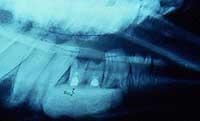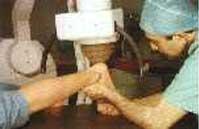Treatment to improve the incorporation of bone grafts
In his thesis, defended by doctor Javier González at the Public University of Navarra, the application of shock waves to bone grafts to rabbits drastically increases vascularization. The study highlights that bone grafts are easier to incorporate by applying shock waves. So far this treatment has only been used in kidney stones and pathological orthopedics.
The aim of the thesis of the doctor from Pamplona has been to demonstrate that such treatment can improve or accelerate the addition of bone grafts. Shock waves are similar to ultrasound, sound waves. These waves are used to treat kidney stones since the 1970s, to break kidney stones. In recent years shock waves have also been used to treat possible delays in the union of tendinitis and broken bones, among others.
To facilitate the incorporation of grafts

Bone grafts are done when the patient lacks a piece of bone, for example, from a tumor that has been removed or from erosion, as in the case of hip prostheses. After two types of fractures, bone grafts are essential: on the one hand we have them fragmented, they are small and do not present big problems, since they are added very quickly. On the other hand, grafts are larger or more structural: they are usually bone fragments of a corpse.
The main problem of the structural graft is that when all the cells are removed it is dead bone. This graft should be added to the patient to form a new bone on the transplanted bone that acts as a support. If this new bone is not completed, the graft may break.
For this reason, Francisco Javier González, in his thesis, has tried to explain that shock waves can cause small cracks in the graft, which allow a better bone filling.
Experiment with 45 rabbits

The experiment was conducted with 45 rabbits. All of them were removed the main metatarsus legs from the left. Later, some rabbits were grafted with their bones (the automents) and others with the bones (the alloys) that other rabbits had, after the death of the cells that had them.
Three groups of 15 rabbits were subsequently formed and treated with shock waves. A group of rabbits were given medium wave doses, another high, and the third was not treated.
Effective dose of bone treatment
The doctor Francisco Javier González highlighted in his work that no significant differences have been found between grafts treated with shock waves or not treated in radiological results, microvascularization and general histology. In microscopic research, on the contrary, cracks in the graft are observed and cells are included.
Also, during the research it is observed that in the rabbit grafts that suffered a higher dose there are more capillaries. The doctor González Arteaga concludes, therefore, that the treatment of shock waves affects the vascularization of bone grafts: the number of vascularization channels in the bone grafts of treated rabbits (both automents and allotments) is much higher than in those who have not received this treatment.
Buletina
Bidali zure helbide elektronikoa eta jaso asteroko buletina zure sarrera-ontzian











